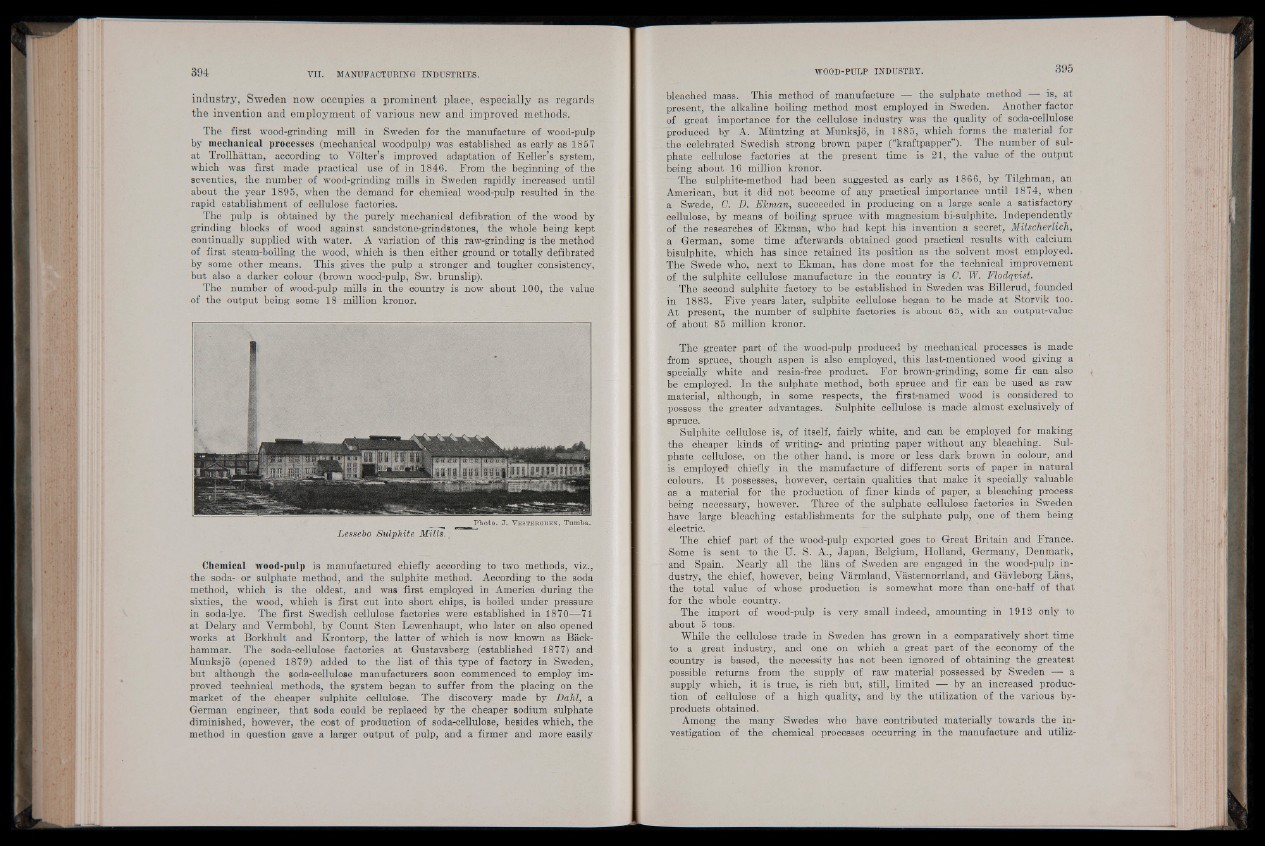
industry, Sweden now occupies a prominent place, especially as regards
the invention and employment of various new and improved methods.
The first wood-grinding mill in Sweden for the manufacture of wood-pulp
by mechanical processes (mechanical woodpulp) was established as early as 1857
at Trollhattan, according to Volter’s improved adaptation of Keller’s system,
which was first made practical use of in 1846. From the beginning of the
seventies, the number of wood-grinding mills in Sweden rapidly increased until
about the year 1895, when the demand for chemical wood-pulp resulted in the
rapid establishment of cellulose factories.
The pulp is obtained by the purely mechanical defibration of the wood by
grinding blocks of wood against sandstone-grindstones, the whole being kept
continually supplied with water. A variation of this raw-grinding is the method
of first steam-boiling the wood, which is then either ground or totally defibrated
by some other means. This gives the pulp a stronger and tougher consistency,
but also a darker colour (brown wood-pulp, Sw. brunslip).
The number of wood-pulp mills in the country is now about 100, the value
of the output being some 18 million kronor.
Photo. J . V e s t e r g b e n , Tnmba.
Lessebo Sulphite Mills. ,
Chemical wood-pulp is manufactured chiefly according to two methods, viz.,
the soda- or sulphate method, and the sulphite method. According to the soda
method, which is the oldest, and was first employed in America during the
sixties, the wood, which is first cut into short chips, is boiled under pressure
in soda-lye. The first Swedish cellulose factories were established in 1870—71
at Delary and "Vermbohl, by Count Sten Lewenhaupt, who later on also opened
works at Borkhult and Krontorp, the latter of which is now known as Back-
hammar. The soda-cellulose factories at Gustavsberg (established 1877) and
Munksjo (opened 1879) added to the list of this type of factory in Sweden,
but although the soda-cellulose manufacturers soon commenced to employ improved
technical methods, the system began to suffer from the placing on the
market of the cheaper sulphite cellulose. The discovery made by Dahl, a
German engineer, that soda could be replaced by the cheaper sodium sulphate
diminished, however, the cost of production of soda-cellulose, besides which, the
method in question gave a larger output of pulp, and a firmer and more easily
bleached mass. This method of manufacture ¡ ^ |t h e sulphate method — is, at
present, the alkaline boiling method most employed in Sweden. Another factor
o f great importance for the cellulose industry was the quality of soda-cellulose
produced by A. Miintzing at Munksjo, in 1885, which forms the material for
the-celebrated Swedish strong brown paper (“kraftpapper”). The number of sulphate
cellulose factories at the present time is 21, the value of the output
being about 16 million kronor.
The sulphite-method had been suggested as early as 1866, by Tilghman, an
American, but it did not become of any practical importance until 1874, when
a Swede, C. D. Ekman, succeeded in producing on a large scale a satisfactory
cellulose, by means of boiling spruce with magnesium bi-sulphite. Independently
of the researches of Ekman, who had kept his invention a secret, Mitscherlich,
a German, some time afterwards obtained good practical results with calcium
bisulphite, which has since retained' its position as the solvent most employed.
The Swede who, next to Ekman, has done most for the technical improvement
of the sulphite cellulose manufacture in the country is C. 1W. Flodqvist.
The second sulphite factory to be established in Sweden was Billerud, founded
in 1883. Five years later, sulphite cellulose began to be made at Storvik too.
At present, the number of sulphite factories is about 65, with an output-value
of about 85 million kronor.
The greater part of the wood-pulp produced by mechanical processes is made
from spruce, though aspen is also employed, this last-mentioned wood giving a
specially white and resin-free product. For brown-grinding, some fir can also
be employed. In the sulphate method, both spruce and fir can be used as raw
material, although, in some respects, the first-named wood is considered to
possess the greater advantages. Sulphite cellulose is made almost exclusively of
spruce.
Sulphite cellulose is, of itself, fairly white, and can be employed for making
the cheaper kinds of writing- and printing paper without any bleaching. Sulphate
cellulose, on the other hand, is more or less dark brown in colour, an d .
is employed- chiefly in the manufacture of different sorts of paper in natural
colours. It possesses, however, certain qualities that make it specially valuable
as a material for the production of finer kinds of paper, a bleaching process
being necessary, however. Three of the sulphate cellulose factories in Sweden
have large bleaching establishments for the sulphate pulp, one of them being
electric.
The chief part of the wood-pulp exported goes to Great Britain and France.
Some is sent to the U. S. A., Japan, Belgium, Holland, Germany, Denmark,
and Spain. Nearly all:.:.the Ians of Sweden are engaged in the wood-pulp industry,
the chief, however, being Varmland, Vasternorrland, and Gavleborg Lans,
the total value of whose production is somewhat more than one-half of that
for the whole country.
The import of wood-pulp is very small indeed, amounting in 1912 only to
about 5 tons.
While the cellulose trade in Sweden has grown in a comparatively short time
to a greatijilndustry, and one on which a great part of the economy of the
country is based, the necessity has not been ignored of obtaining the greatest
possible returns from the. supply of raw material possessed by Sweden - a
supply which, it is true, is rich but, still, limited — by an increased production
of cellulose of a high quality, and by the utilization of the various byproducts
obtained.
Among the many Swedes who have contributed materially towards the investigation
of the chemical processes occurring in the manufacture and utiliz